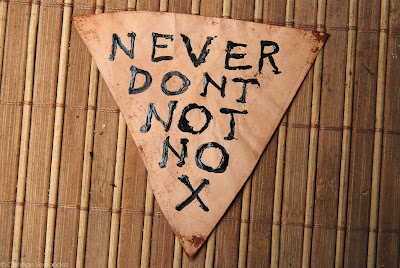The spirit of the north wind.
This is my first high-day ritual incorporating the Gaul hearth culture. One of the great challenges was to find the Gaulish equivalent for Mabon.
There is no clear evidence as to whether the Gauls celebrate the Automnal Equinox. In fact, it isn't very clear either whether there's a Gaulish word for "autumn". Scholars suggest the words
uogiamos ("before winter"), or
messus ("harvest"), but being in the Pacific tropics I wanted a less season-related word. I may be worshiping Gaulish gods but I'd like to keep my rituals relevant to the spirit of the land.
In the ADF dedicant manual, the Gaulish fall equinox festival is called
Diocomrextios. I could hardly find any resources as to the origin of this word though, and it seems that the more correct, or at least the more popular reconstruction of the word is
Tiocobrextio. However, far from what the manual says, this is not a festival specific to the fall equinox. In the Coligny calendar, an ancient artifact that has preserved the time keeping method of the Gauls,
Tiocobrextio appears a few times throughout the Gaulish year, notably in the months of
Simiuissonā (around May) and
Ēdrini (around August). The word can either mean a "day of justice" (
rextu, "law", "justice") or a "day of magic" (
brixto, "magic", "incantation"). It works for me either way. A day for doing magic and for making things right.
It might be preposterous to make associations from Western astrology, but this being the time when the Sun enters Libra (the scales of Justice) makes it even easier for me to accept
Tiocobrextio. The narrative may have changed but the theme remains largely the same with Mabon: transition, equlibrium, moderation.

Wheel and lightning. Votive offerings to the thunder god.
The Wheel of Taranis
Taranis is the Gaulish god of the skies and lord of storms. His most popular symbol is the wheel, which is associated with thunder. It is said that in the olden days, the sound of thunder was thought to be made by Taranis' chariot passing through the heavens. In this age of weather satellites, I see Taranis' wheels in tropical cyclones and in the shifting currents of the monsoon winds.
In the Philippines, the weeks following the fall equinox is a period of transition from wet to dry season. The cool, northern winds begin to prevail over the rainy, southwesterly winds. This also signals the peak of the
migration of birds coming from the cold north going to the warmer south. The Philippine islands, sitting smack in the middle of the Asian and Australian continents, serves as a stop-over for the migratory birds, hence earning its title, "the avian archipelago".
I think it's a wonderful synchronicity that, in the old Filipino myth about the creation of man, the north wind, Amihan, is represented by a giant bird.

The boon of the tropics (clockwise starting from the big, spiky one):
durian, rambutan, marang, lanzones and atis.
A Tropical Harvest
I usually just have wine and bread (and the occasional chocolate bar) for the celebratory feast, but from now on I am resolved to buy local seasonal produce. It's healthy; it's a good way to attune with the land; and it's quite cheap. For just a litte more than 200 pesos, I got enough food to share with family. Therefore, it's also one way to get the rest of the non-pagan household to join in with the celebration.
We may not have the corn-and-grain type, pre-winter harvest of the temperate lands, but we still do have seasonal crops. And it just happens that the fruits in season this time of the year are the really weird-looking and funky-smelling ones. Here's what I had in the shopping list:
- Durián - Banned in malls, hotels and train stations because of its infamous, foul odor; and occasionally bludgeoning innocent people to death passing by under it's tree, this so-called "king of fruits" in the tropics is actually more like the super-villain of fruits.
- Rambután - Very cheap and very nutritious. Soft, furry, and sturdy. I think they would make great stress balls too.
- Márang - Exudes a strong smell even unopen, but the scent is more pleasant than Durian's. It's one of the most delicious and addicting fruit I've ever tasted.
- Lanzónes - The grapes of the tropics. Sour and sweet and tastes a bit like lychee. I actually find more joy popping them open than eating them.
- Átis - A friend told me they look like dinosaur balls - as if he'd actually seen a pair. I like the taste, but the seeds get in the way from fully enjoying it.

My dedicant shrine. The sacred fire, a lamp with a triple flame. The sacred well, a pot filled with rain water. The sacred tree, represented by the goddess Danu with a symbolic tree design on her dress and standing on a triple spiral, a symbol of the convergence of the three worlds.
Offerings and libations. I had Korean soju for ritual drink.
The dedicant shrine, post-ritual.
Perth-Sowilo-Dagaz denotes a bright new beginning.
Votive offerings to Taranis by a storm drain.
Basbasan Nawa!
Update - Oct 15, 2012: I think I'm changing the name to Cantlos - the name by which the Three Cranes Grove, an ADF grove which adopts the Gaulish hearth culture, calls this High Day. Cantlos is the last month of the Gaulish year, corresponding roughly to September, and literally means "the month of songs". This, being the month of my birth day, makes better sense for me. It's also a lot less mouthful (and sounds less pretentious) than Tiocobrextio. Why haven't I discovered this sooner?















































































